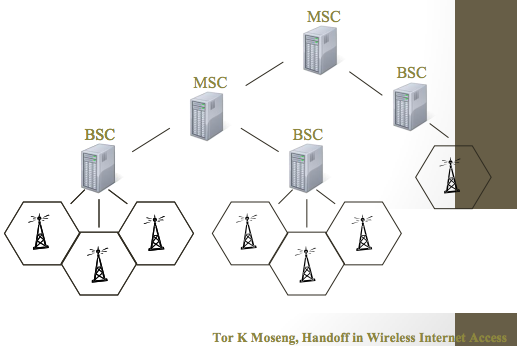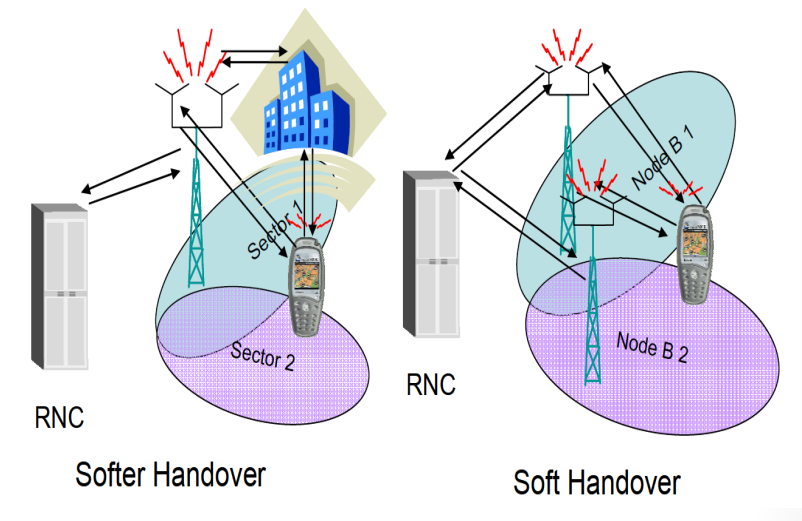Mobility and Handover in mobile systems
From its-wiki.no
| Wiki for ITS | ||||||
|---|---|---|---|---|---|---|
|
Mobility and Handover in mobile systems
| Course | UNIK4700, UNIK9700 |
|---|---|
| Title | Mobility & Handover in mobile systems |
| Lecture date | 2012/10/28 0900-1200 |
| presented | by Naji Ahmed Kadah, Josef Noll |
| Objective | The objective of this lecture is to explain the principles of Mobility and Handover (Handoffs) in mobile communications. |
| Learning outcomes | What will we learn today:
|
| Pensum (read before) | |
| References (further info) | References:
|
| Keywords | Handover, Mobile Systems, Mobility |
this page was created by Special:FormEdit/Lecture, and can be edited by Special:FormEdit/Lecture/Mobility and Handover in mobile systems.
Test yourself, answer these questions
- How does MobileIP work? What are the advantages and the limits of mobile IP?
- Describe the difference between MobileIP and UMTS/GPRS mobility management.
- What happens when mobile moves from one cell to another?
- Differences between Hard & Soft handoff
- When will a handoff occur?
- Reasons for failed handoff.
- Ways to improve handoff performance.
Lecture notes
- Media:UNIK4700-L9H12.pdf
- Media:MobilityPrinciples_comments.pdf
- Video: mms://lux.unik.no/UNIK4700-JN/UNIK-20121102.wmv
⌘ E1 - Mobile Network mobility
⌘ Mobility principles
- Continuous mobility enables continuous availability of services while the user moves
- Discrete mobility enables the availability of services within certain areas and for certain access points, e.g home and office, but not while moving from one area to another.
- Portability is an example of discrete terminal mobility, where it is only allowed to move a terminal from one plug to another.
⌘ Handover
Handover: Changing the point of connection while communicating
- When a mobile user travels from one area of coverage or cell to another cell within a call’s duration the call should be transferred to the new cell’s base station
Why handover is needed?
- Mobility
⌘ GSM Handover types
Network-controlled, mobile terminal assisted handover
- The network takes the handover decisions
- The mobile terminal supervises and reports its signal quality
Four types of handover
- Intra BTS handover
- Intra-BSC handover
- Inter-BSC handover
- Inter-MSC handover
⌘ GSM Handover
Mechanisms for requesting hand-over
- power lever in handset is too low
- signal/noise ratio is too low
- bit-error-rate is too high
- ...
Procedure
- handset requires hand-over
- base-station decides
Alternatives
- hand-over to neighbour cell
- hand-over to different RNC/BSC
- first registration (roaming)
⌘ Handover in UMTS
For purely inter W-CDMA technology, there are three basic types of handover:
- Hard Handover
- Soft Handover
- Softer Handover
⌘ Hard Handover
- Break Before Make
- The network decides a handover is required dependent upon the signal strengths of the existing link, and the strengths of broadcast channels of adjacent cells.
- The link between the existing NodeB and the UE is broken.
- A new link is established between the new NodeB and the UE.
⌘ Soft Handover
- Occurs when the ME is moving in the overlapping coverage area.
- The ME communicate and receive the signals from the NodeB’s which their signals are overlapping.
- The rake receiver is needed in the UE (ME) to combine the two signals
- In the uplink , the best quality frame of the two signals is selected. The selection is made by the outer loop power control algorithm measurement.
- Negatives: It need to indicate rescources(capacity) on both NodeBs
⌘ Softer Handover
- Softer handover is a special case of soft handover where the radio links that are added and removed belong to the same Node B.
- In softer Handover , the NodeB can receive the signal in macro diversity with maximum ratio combining.
- In soft handover macro diversity with selection combining is selected.
⌘ UMTS to GSM handover
- Compressed mode handover: Using compressed mode handover the UE uses the gaps in transmission that occur to analyse the reception of local GSM base stations. The UE uses the neighbour list provided by the UMTS network to monitor and select a suitable candidate base station. Having selected a suitable base station the handover takes place, but without any time synchronisation having occurred.
- Blind handover: This form of handover occurs when the base station hands off the UE by passing it the details of the new cell to the UE without linking to it and setting the timing, etc of the mobile for the new cell. In this mode, the network selects what it believes to be the optimum GSM based station. The UE first locates the broadcast channel of the new cell, gains timing synchronisation and then carries out non-synchronised intercell handover.
⌘ GSM to UMTS
- Handover from GSM to UMTS : This form of handover is supported within GSM and a "neighbour list" was established to enable this occur easily. As the GSM / 2G network is normally more extensive than the 3G network, this type of handover does not normally occur when the UE leaves a coverage area and must quickly find a new base station to maintain contact.
- The handover from GSM to UMTS occurs to provide an improvement in performance and can normally take place only when the conditions are right. The neighbour list will inform the UE when this may happen.
⌘ Handoff and performance
- Handoffs are expensive to execute, so unnecessary handoffs should be avoided.
- If the handoff criteria are not chosen appropriately, then in the overlapping region between the two BS coverage area boundaries, the call might be handed back and forth several times between them.
- If the criteria are too conservative, then the call may be lost before the handoff can take place.
- The handoff decision-making criteria become even more critical with the evolution to smaller cell sizes, which is happening to increase the capacity of systems and to reduce power requirements of MSs.
- Unreliable and inefficient handoff procedures will reduce the quality and reliability of the system.
⌘ References
- Handoff in GSM/GPRS Cellular Systems http://www.ieee802.org/21/archived_docs/Documents/OtherDocuments/Handoff_Freedman.pdf
- LTE Handover: http://reference.kfupm.edu.sa/content/d/e/design_and_evaluation_of_a_handover_deci_72726.pdf
- Handover between GSM & UMTS : http://www.ericsson.com/ne/res/thecompany/docs/publications/ericsson_review/2003/2003011.pdf
- Soft Handovers in CDMA tech.: [1]
⌘ Basics of Handover, examples from GSM and UMTS
- Media:Basics_Handover.pdf (by Naji Ahmed Kadah)
- Media:Basics_Handover_comments.pdf

